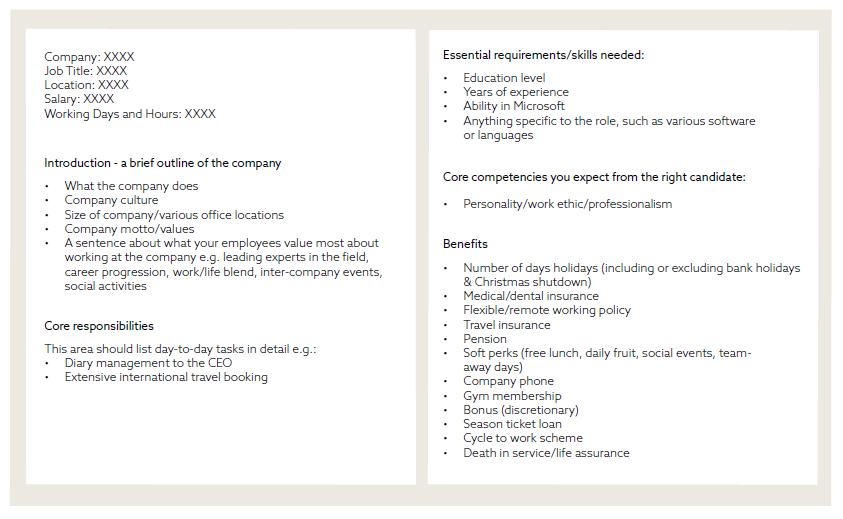Supporting Employees Through Menopause
Fatigue, hot flushes, memory lapses and anxiety are just a few of the challenging symptoms that people going through menopause will face, often while juggling demanding professional roles. Despite this,…
We have matched exceptional jobseekers with fantastic businesses since 2001, and for those looking to recruit staff, the recruitment and selection process has changed drastically since then. The pandemic instigated a significant shift in the way we work and, therefore, a change in the desires of both businesses and jobseekers.
Now, we’re seeing another dramatic shift in hiring. Both the pandemic and the calls for increased diversity in the workplace have forced many businesses to transform their recruitment and selection processes. From the conversations we’re having with employers in the wake of this, it’s clear there is a need for a simple, straightforward guide to the basics of the recruitment and selection process from start to finish.
Recruitment and selection processes refer to the procedure of finding suitable candidates for a company to fill job vacancies. It involves identifying the requirements of a job, advertising the position, defining the requirements of the position, and choosing the appropriate candidate for the job.
Learning the recruitment and selection process effectively is essential for employers who want to recruit suitable staff, save the business time and optimise resources. Following each step of the process through to selection will also lead to better retention rates and long-term hires.
What is the difference between recruitment and selection?
Recruitment refers to the process of finding potential applications for a role. If you’re working with a recruiter, this might be with an initial briefing to understand exactly what you’re looking for so that they might then write a job ad, search for candidates, and provide a shortlist. Once you’ve signed off on this, the next step would involve an interview process. Selection then follows, which is the route to hiring your preferred employee from those you’ve met.
In other words, selection is the process of choosing the right person for the job.
A comprehensive recruitment and selection policy ensures consistency in the process and helps to manage expectations for all parties. Such a policy serves as a guiding framework that outlines the organisation’s principles, procedures and best practices for attracting, assessing, and hiring potential candidates.
Firstly, a well-defined policy ensures consistency and fairness throughout the recruitment process. Establishing clear guidelines and criteria helps minimise any potential biases and ensures that all candidates are assessed on their merits and qualifications. Moreover, a recruitment and selection policy promotes transparency, both internally and externally. It provides employees with a clear understanding of the company’s hiring practices, ensuring a consistent approach and reducing ambiguity or confusion. Externally, it presents a professional and ethical image of the company, fostering trust between jobseekers and employers. Additionally, a robust policy helps mitigate legal risks and compliance issues by ensuring adherence to applicable laws and regulations. It outlines procedures for handling sensitive information, ensuring confidentiality and data protection.
Overall, a recruitment and selection policy is crucial for maintaining a fair, efficient and legally compliant recruitment process, ultimately leading to the identification and hiring of the most suitable candidates for the organisation’s needs.
Let’s look at Tiger’s recruitment and selection process.
There are many elements to consider when attracting talent in the UAE. As the majority of the population are expatriates of working age (with only 11.48% of the population made up of UAE citizens), it’s important to consider what your ideal worker will be attracted to.
The UAE has long been attractive to expatriates, due to companies offering high salaries, zero income tax, relocation packages, school tuition and other benefits which aren’t offered in many other countries in the world. The lifestyle of living in the UAE is also attractive for some, with warm weather all year round and new developments offering many creature comforts. If you’re in a position to offer the above, that’s fantastic. However, employers can also attract expats by developing a positive, international employer brand and progression opportunities.
For a long time, UAE citizens were attracted to working in the public sector, as they were able to access a larger number of annual leave days and shorter working hours. While the government has since worked on equalising the gap between the public and private sectors, some Emiratis may still perceive the public sector as a more desirable workplace. Therefore, an employer who offers great, individualised benefits is more likely to attract Emirati employees, like flexible working.

Attracting Emirati talent is now an essential consideration for many businesses due to Emiratisation. In the UAE, Article 14 of the UAE Labour Law mandates that Emirati candidates must be prioritised by employers in certain companies due to high unemployment levels among locals. As such, you will likely have to take this into account when selecting talent to work in your company.
There are benefits from hiring Emirati talent, as companies have the opportunity to save on Ministry of Human Resources and Emiratisation fees, among other discounts. If you’re looking for more information or are unfamiliar with the requirements, our guide to Emiratisation will help.
A job specification (job spec) or job description is a document created for candidates to understand the details of the job before they apply for it. It’s an easy way for them to understand what the job will entail and decide if it’s the right position for them.
If you’re looking for help in writing job descriptions and best practices around this, follow the format below:

If you’re not using a recruiter, likely, you will likely also write a job advertisement for the role in-house. The ultimate goal of a job ad is to attract the best talent, so it’s worth taking the time to write a fantastic ad.
While you want to attract the best talent, all role expectations must be communicated clearly and understood by the employee before any type of commitment is made. If a role includes a large amount of administration or irregular hours, mention it – otherwise, a discrepancy between what an employee expects and what you can deliver could arise.
Other elements to consider when writing a job ad include spelling and grammar, tone of voice, a clear heading, simple language and enthusiasm. Writing the best possible job ad will also reflect positively on your employer brand, which ensures your opportunity is considered by the right candidates.
There are also common mistakes that we see many employers make when writing their job ads. The following are some things to avoid:
Remember, a job ad and a job description are different: a job description describes what a candidate does for you, whereas an ad should focus on what you can for them.
If using a recruiter, they will likely write the job ad for you once you’ve provided them with a thorough job description or spec.
When looking to attract talented candidates, it’s useful to think outside the box (and the traditional job ad). It could be as elaborate as a creative job ad or as simple as setting up a strong referral process. Looking for inspiration to get you started? Head over to our blog on creative ways to attract the best talent.
Remember, by 2025, millennials will make up three-quarters of the workforce, so it’s incredibly important that you take them into account as part of your attraction strategy. You can do this by investing in your digital presence. They are the first generation to grow up surrounded by digital technologies, and as such, they will rely on the internet for information about your employer brand. Invest in building a digital presence that’s attractive to the best talent, with consistent messaging and experiences across all sites. Don’t be afraid to use social media for sourcing – LinkedIn, Facebook, Twitter, and Glassdoor can all be effective.
When looking at candidates’ CVs, it’s important to know what to look out for with a quick scan of the document. Below, we outline what we look for in a great CV, along with common misconceptions we’ve heard along the way.
So, what should a CV look like? Look for:
Find a good example of a CV below:

Education is important, but often employers will rule out candidates who don’t have a bachelor’s degree, even if they are intelligent (e.g. strong A-levels but have chosen not to go to university). We see this quite often when hiring personal assistants and office managers. Remember, if you do rule out a candidate based on their university qualifications, you’re at risk of narrowing your pool of candidates and potentially excluding your dream hire!
These sections are a fantastic opportunity to learn more about a candidate on a personal level, behind the CV. This, in turn, gives you a better indication of their personality and if they are likely to be a good fit for your workplace. It’s also a good indication of the level of imagination and creativity a candidate possesses, as there isn’t a lot of room for individual expression on the rest of the CV. As recruiters, we use this information to help us do just that, so we would highly recommend more than a cursory glance at these sections.
It can be tempting to hire prospective employees based on specific skillsets, experience, and referrals. Personality type and soft skills like patience and enthusiasm, however, factor into workers’ success just as much (if not more) than their ability to carry out the role. Unlike industry experience and technical skills, soft skills often cannot be taught, though they can make or break a successful onboarding process.
While CVs may outline the soft skills of a candidate, it’s unlikely you’ll be able to completely understand the breadth of these from this alone. Therefore, you should always try to go into soft skills in more detail in the later stages of the process.
Several employers find a CV with little movement unusual or an indication that the candidate won’t stay in one role for long. While this may have been the case in the past, it’s now very normal for a candidate to ‘hop’ from one role to the next, particularly millennials.
When you review the CV of a job-hopper, consider the following points:
Essentially, job hopping isn’t necessarily a negative thing, so never exclude a candidate based on this reason alone.
For more tips, read our blog on how to screen CVs.
Effective interview techniques are essential to get the most out of the experience. If done well, you’ll better understand your employees’ motivations and be better equipped to nurture their desired career path for the benefit of your business.
As the interviewer, it’s your job to make the candidate feel at ease in the situation (as they are probably nervous) when conducting interviews. Remember: a calm, informative and honest interview will ensure the candidate performs at their best, allowing you to ultimately make the right decision. It’s also a good idea for hiring managers to prepare for an interview beforehand.

Effective interview techniques are essential to get the most out of the experience. If done well, you’ll better understand your employees’ motivations and be better equipped to nurture their desired career path for the benefit of your business.
As the interviewer, it’s your job to make the candidate feel at ease in the situation (as they are probably nervous) when conducting interviews. Remember: a calm, informative and honest interview will ensure the candidate performs at their best, allowing you to ultimately make the right decision. It’s also a good idea for hiring managers to prepare for an interview beforehand.
If the candidate feels at ease, you will get the best out of them in the interview and have a more accurate representation of their character/ skill set. If working with a recruiter, brief them on what the interview will entail so that they can prepare the candidate for what to expect.
This includes:
In the interview, you can make the candidate feel at ease by adopting friendly, open and warm body language. As mentioned above, start the interview by outlining what the candidate can expect. It’s also a good idea to give the candidate an overview of the company and the role, as this will allow them to settle in and calm their nerves before answering questions.
There are topics you should avoid venturing into during the interview, as they have no bearing on the candidate’s ability to perform the role successfully. These include those topics to do with protected characteristics (as mentioned above), but also questions about social media accounts and leading questions.
In the beginning, reiterate what structure the interview will follow and give the candidate an overview of the company and role. This is an effective interviewing technique as it will make the candidate feel at ease and give them time to tailor their answers and choose the best examples.
Next, talk through a candidate’s CV and experience. This, alongside targeted questioning, will take up most of the interview. The goal here is to find out about the candidate, their previous experience and what they’re looking for in a new role. Questions to ask at this stage may include:
After your questions, give the interviewee a chance to ask their own. This allows them to show an interest in the role and company, as well as proves they’ve done background research into the company.
End the interview by explaining what the next steps might be and when the candidate can expect to hear feedback. Regardless of how well the interview went, always thank a candidate for their time and finish on a positive note.
The length of the interview depends on the role, the level of experience and the number of stages in the interview process. We recommend a minimum of 20 minutes for a first-stage interview (if there are several stages). A single interview could take up to 45 minutes, but try not to keep the candidate too long, especially if they are meeting different people.
While it’s important to tailor interview questions depending on the specific role the candidates are applying for, there are several general questions employers should always ask in an interview. Below, we break down the specific types of questions that can be asked when assessing a candidate.
There are different types of questions that an employer can ask when conducting interviews. These include:
A combination of both competency and situational questions will provide you with a holistic view of a candidate’s thought process and problem-solving abilities. These are open questions and will, therefore require the candidate to tell you a bit of a story and paint a complete picture of their experience and approach to work. These should be defined ahead of the interview with the desired competencies in mind.
Closed questions can be useful, too. These are the ones that only need one-word answers. They have their place, especially in an interview environment where you might be asking prospective permanent staff technical questions to test their understanding. Equally, if you’re rushed for time, closed questions can be a speedy way of generating easy conversation at the start or end of a meeting.
Competency-based interviews are becoming increasingly popular, with companies opting to ask broad questions that reveal a candidate’s skills and personality behind their CV.
Competency-based questions typically lead a candidate towards describing a situation and/or task.
For example, you may start a question by saying:
Competency-based interview questions always require an example of something a candidate has done in the past (to use as an example of their competency or behaviour in a certain situation).
Competency-based interviews allow you to use a set script or a score-based system for assessing candidates. This typically means that all candidates are asked the same questions, allowing there to be a fair interview process in place, where every candidate has an equal opportunity to shine. Competency questions force candidates to recall their personal experiences, which may then elaborate on.
Finally, these questions allow candidates to show they have all the experience and capabilities to do the job well.
 As with every type of interview, there are cons associated with using competency-based questions. In some cases, candidates spend so much time preparing polished answers that they unintentionally give the impression that they have a robotic personality. Also, some may struggle with the open-ended nature of the questions and end up giving poorly constructed or unclear answers. Typically, these are the most challenging types of questions — some employers report that they find candidates will freeze if they feel they’re put on the spot with a competency-based question. Finally, if an interview focuses exclusively on competencies, a candidate might not get the opportunity to convey their emotions or motivations.
As with every type of interview, there are cons associated with using competency-based questions. In some cases, candidates spend so much time preparing polished answers that they unintentionally give the impression that they have a robotic personality. Also, some may struggle with the open-ended nature of the questions and end up giving poorly constructed or unclear answers. Typically, these are the most challenging types of questions — some employers report that they find candidates will freeze if they feel they’re put on the spot with a competency-based question. Finally, if an interview focuses exclusively on competencies, a candidate might not get the opportunity to convey their emotions or motivations.
Essentially, what you’re looking for is someone who can positively contribute to the business by using their pre-existing knowledge and any new skills they learn on the job. It’s important to establish that they possess the relevant skills for the advertised role, which can be conducted through a small skills-based task.
 The offer process and securing a candidate
The offer process and securing a candidateCongratulations! All your hard work throughout the interview process has paid off, and you’ve found your dream hire! Below, we outline the next steps to take to ensure you win over your chosen candidate as quickly as possible.
The offer process is an integral part of securing your dream candidate. Essentially, strong communication and acting quickly are key.
This process begins before interviews start, as communicating timings and setting expectations around the interview process are essential. If working with a recruiter, talk to them to learn important information, such as where the candidates might be in recruitment processes for other positions and salary expectations.
When making an offer to a candidate, this usually begins with a verbal conversation. During this talk, you may mention salary, benefits, an expected start date and reference requirements.
In some cases, there may be some negotiation and working around a counter-offer from the existing employer.
Once the candidate accepts, you will be able to get in contact with them directly (if you’ve been using a recruitment agency up to this point). At this stage, the contract and offer letter is sent to the candidate.
There are a few key points to include in a contract or job offer letter. These include:
You will also need to carry out any background and reference checks and talk to the candidate about when they will hand in notice with their current employer (if applicable).
Finally, communicate any final information pre-starting with the candidate. This could include the start date/time, who to ask for on arrival and how the onboarding process will go ahead.
The hiring process doesn’t end at the candidate’s acceptance of the job. Without a smooth introduction to the organisation in the days following their acceptance, you are in danger of alienating your recruits and impacting their motivation and productivity.
Effective inductions are timely, organised and engaging. The aim is to inspire and excite new starters while giving a good first impression of the company. They should set out an organisation’s mission and vision for them, while educating them about the company’s history, culture and values.
Your employee onboarding process could take up to three months, depending on the level and scope of the role. HR staff, line managers or the office manager can help onboard new staff. We’ve outlined the best practices for onboarding below:
A successful onboarding process doesn’t begin from the new employee’s start date. As soon as the individual accepts the role, you should be managing your recruit’s perception of the organisation’s brand and the team they’re about to join.
On a new starter’s first day:
It’s a good idea for HR to organise catch-ups with individual managers once they’ve started the role. Communicate to managers that this is an important step in the new starter’s onboarding process, as it will also help them to feel as though senior staff are taking a genuine interest in them and their skills.
The first few weeks are the most important time for any new starter. In this time, they’ll form an opinion of your company which will be hard to change if it isn’t a positive one.
Send around an email asking their colleagues to introduce themselves so that they have informal introductions over a few days. Introducing them to everyone at once will be overwhelming and the recruit is unlikely to remember any names. Organising a buddy who can take them for lunch and show them around the local area is also a good way to relax and orientate them.
Continue holding regular catch-ups and check-ins, and allow different team members to take part in the induction process to draw on their own skill sets and give them some responsibility when training the new starter.

Recognise that a new employee will take some time to be able to work at their full capacity. If you enforce deadlines too quickly, you could get the wrong impression of their capabilities, as they may be tempted to rush tasks to deliver them on time. Small mistakes are likely to be made while the recruit is taking in all this new information, so try to set them small tasks and evaluate their performance after each is completed, ensuring that you give constructive feedback.
If onboarding remotely, it’s important that:
Remember, the onboarding process can be overwhelming for a new starter. It’s important that everyone in the office reaches out and makes them feel welcome.
If you’d like any additional guidance on recruiting new staff, get in touch with us today and we’ll be able to guide you through the process. If you’d like to request the PDF version of our Interview and Selection guide, please email us at marketing@tiger-recruitment.co.uk.
How to measure effectiveness of recruitment and selection process
Measuring the effectiveness of the recruitment and selection process helps to identify areas of improvement and ensure successful hiring outcomes. There are a few methods and key metrics you can use to measure the effectiveness of your recruitment and selection process:
How can we improve the recruitment and selection process?
Improving the recruitment and selection process involves making strategic changes to attract and identify the most suitable candidates for a job. These can include:
Sign up for the latest workplace insights.